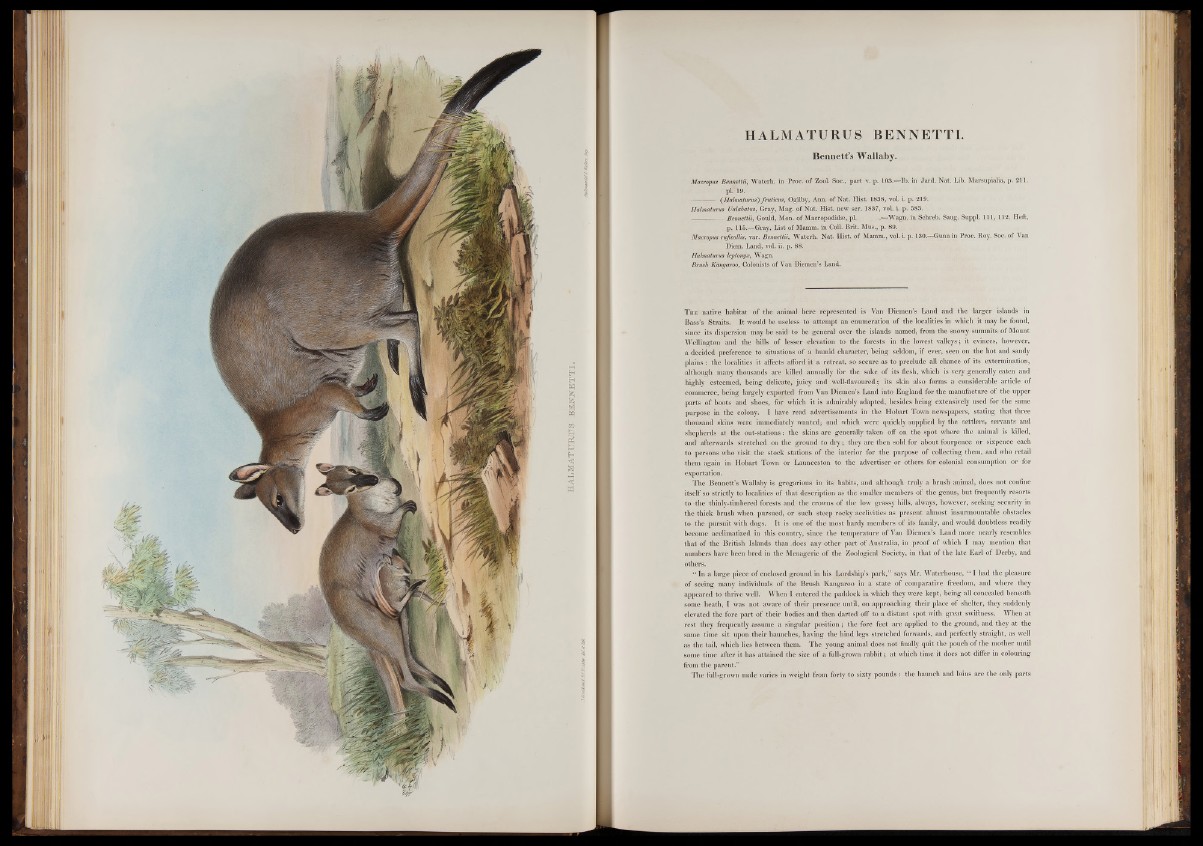
HAL MAT FRITS BKETH i
HALMATURU8 BENNETTI .
Bennett’s Wallaby.
Macropus Bennettii, Waterh. in Proc. o f Zool: Soc., part v. p. 103.—lb. in Jard. Nat. Lib. Marsupialia, p. 211.
plv 19.
— (Habnaturus') fruticus, Ogilby, Ann. of Nat. Hist. 1838, vol. i. ;p. 219.
Halmaturus Ualabatus, Gray, Mag. of Nat. Hist, new ser. 1837, vol. i. p. 583.
. Bennettii, Gould, Mon. ofMacropodidse, pi. .—Wagn. in Schreb. Saug. Suppl. I l l , 112. Heft,
p. 115.—Gray, List of Mamm. in Coll. Brit. Mus., p. 89.
Macropus ruficollis, var. Bennettii, Waterh. Nat. Hist, of Mamm., vol. i. p. 130.—Gunn in Proc. Roy. Soc. of Van
Diem. Land, vol. ii. p. 88.
Habnaturus leptonyx, Wagn.
Brush Kangaroo, Colonists of Van Diemen’s Land.
T h e native habitat of the animal here represented is Van Diemen’s Land and the larger islands in
Bass’s Straits. It would be useless to attempt an enumeration of the localities in which it may be found,
since its dispersion may be said to be general over the islands named, from the snowy summits of Mount
Wellington and the hills of lesser elevation to the forests in the lowest valleys; it evinces, however,
a decided preference to situations of a humid character, being seldom, if ever, seen on the hot and sandy
plains : the localities it affects afford it a retreat, so secure as to preclude all chance of its extermination,
although many thousands are killed annually for the sake of its flesh, which is very generally eaten and
highly esteemed, being delicate, juicy and well-flavoured; its skin also forms a considerable article of
commerce, being largely exported from Van Diemen’s Land into England for the manufacture of the upper
parts of boots and shoes, for which it is admirably adapted, besides being extensively used for the same
purpose in the colony. I have read advertisements in the Hobart Town newspapers, stating that three
thousand skins were immediately wanted, and which were quickly supplied by the settlers, servants and
shepherds at the out-stations: the skins are generally taken off on the spot where the animal is killed,
and afterwards stretched on the ground to dry; they are then sold for about fourpence or sixpence each
to persons who visit the stock stations of the interior for the purpose of collecting them, and who retail
them again in Hobart Town or Launceston to the advertiser or others for colonial consumption or for
exportation.
The Bennett’s Wallaby is gregarious in its habits, and although truly a brush animal, does not confine
itself so strictly to localities of that description as the smaller members of the genus, but frequently resorts
to the thinly-timbered forests and the crowns of the low grassy hills, always, however, seeking security in
the thick brush when pursued, or such steep rocky acclivities as present almost insurmountable obstacles
to the pursuit with dogs. It is one of the most hardy members of its family, and would doubtless readily
become acclimatized in this country, since the temperature of Van Diemen’s Land more nearly resembles
that of the British Islands than .does any other part of Australia, in proof of which I may mention that
numbers have been bred in the Menagerie of the Zoological Society, in that of the late Earl of Derby, and
others.
“ In a large piece of enclosed ground in his Lordship’s park,” says Mr. Waterhouse, “ I had the pleasure
of seeing many individuals of the Brush Kangaroo in a state of comparative freedom, and where they
appeared to thrive well. When I entered the paddock in which they were kept, being all concealed beneath
some heath, I was not aware of their presence until, on approaching their place of shelter, they suddenly
elevated the fore part of their bodies and then darted off to a distant spot with great swiftness. When at
rest they frequently assume a singular position; the fore feet are applied to the ground, and they at the
same time sit upon their haunches, having the hind legs stretched forwards, and perfectly straight, as well
as the tail, which lies between them. The young animal does not finally quit the pouch of the mother until
some time after it has attained the size of a full-grown rabbit; at which time it does not differ in colouring
from the parent.”
The full-grown male varies in weight from forty to sixty pounds : the haunch and loins are the only parts